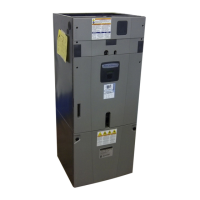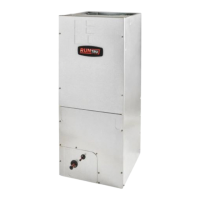122 CLCH-SVX07C-EN
Routine Maintenance
WARNING
No Step Surface!
Do not walk on the sheet metal drain pan. Walking on the drain pan could cause the supporting
metal to collapse. Failure of the drain pan could result in death or serious injury.
The condensate drain pan and drain line must be checked to assure the condensate drains as
designed. This inspection should occur a minimum of every six months or more often as dictated
by operating experience.
If evidence of standing water or condensate overflow exists, identify and remedy the cause
immediately. Refer to “Troubleshooting” on page 118 for possible causes and solutions.
To clean drain pans:
1. Disconnect all electrical power to the unit.
2. Wearing the appropriate personal protective equipment, remove any standing water.
3. Scrape solid matter off of the drain pan.
4. Vacuum the drain pan with a vacuum device that uses high-efficiency particulate arrestance
(HEPA) filters with a minimum efficiency of 99.97 percent at 0.3 micron particle size.
5. Thoroughly clean any contaminated area(s) with a mild bleach and water solution or an EPA-
approved sanitizer specifically designed for HVAC use.
6. Immediately rinse the affected surfaces thoroughly with fresh water and a fresh sponge to
prevent potential corrosion of metal surfaces.
7. Allow the unit to dry completely before putting it back into service.
8. Be careful any contaminated material does not contact other areas of the unit or building.
Properly dispose of all contaminated materials and cleaning solution.
Fans
Inspecting and Cleaning Fans
WARNING
Rotating Components!
Disconnect all electric power, including remote disconnects before servicing. Follow proper
lockout/ tagout procedures to ensure the equipment cannot be inadvertently energized. Secure
drive sheaves to ensure rotor cannot freewheel. Failure to secure drive sheaves or disconnect
power before servicing could result in death or serious injury.
Fan sections of air handlers should be inspected every six months at a minimum or more frequently
if operating experience dictates. If evidence of microbial growth (mold) is found, identify and
remedy the cause immediately. Refer to “Troubleshooting” on page 118 for possible causes and
solutions. To clean the fan section:
1. Disconnect all electrical power to the unit.
2. Wearing the appropriate personal protective equipment, remove any contamination.
3. Vacuum the section with a vacuum device that uses high-efficiency particulate arrestance
(HEPA) filters with a minimum efficiency of 99.97 percent at 0.3 micron particle size.
4. Thoroughly clean any contaminated area(s) with a mild bleach and water solution or an EPA-
approved sanitizer specifically designed for HVAC use.
5. Immediately rinse the affected surfaces thoroughly with fresh water and a fresh sponge to
prevent potential corrosion of metal surfaces.
6. Allow the unit to dry completely before putting it back into service.

